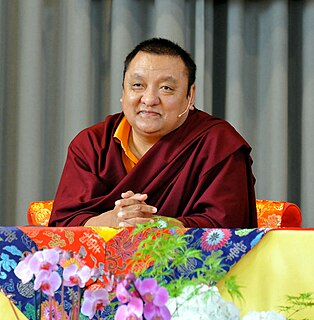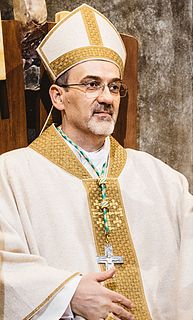
The Reverend is an honorific style most often placed before the names of Christian clergy and ministers. There are sometimes differences in the way the style is used in different countries and church traditions. The Reverend is correctly called a style but is often and in some dictionaries called a title, form of address, or title of respect. The style is also sometimes used by leaders in non-Christian religions such as Judaism and Buddhism.
A style of office or form/manner of address, is an official or legally recognized form of address for a person or other entity, and may often be used in conjunction with a personal title. A style, by tradition or law, precedes a reference to a person who holds a post or political office, and is sometimes used to refer to the office itself. An honorific can also be awarded to an individual in a personal capacity. Such styles are particularly associated with monarchies, where they may be used by a wife of an office holder or of a prince of the blood, for the duration of their marriage. They are also almost universally used for presidents in republics and in many countries for members of legislative bodies, higher-ranking judges and senior constitutional office holders. Leading religious figures also have styles.

The highest-ranking bishops in Eastern Orthodoxy, Oriental Orthodoxy, the Catholic Church, the Hussite Church, and the Church of the East are termed patriarchs.

Excellency is an honorific style given to certain high-level officers of a sovereign state, officials of an international organization, or members of an aristocracy. Once entitled to the title "Excellency", the holder usually retains the right to that courtesy throughout their lifetime, although in some cases the title is attached to a particular office, and is held only for the duration of that office.

The Shamarpa, also known as Shamar Rinpoche, or more formally Künzig Shamar Rinpoche, is a lineage holder of the Karma Kagyu school of Tibetan Buddhism and is regarded to be the mind manifestation of Amitābha. He is traditionally associated with Yangpachen Monastery near Lhasa.

In the English language, an honorific is a form of address conveying esteem, courtesy or respect. These can be titles prefixing a person's name, e.g.: Mr, Mrs, Miss, Ms, Mx,Sir, Dr, Cllr, Lady or Lord, or titles or positions that can appear as a form of address without the person's name, as in Mr President, General, Captain, Father, Doctor or Earl.

His Holiness is a style and form of address for some supreme religious leaders. The title is most notably used by the pope, Oriental Orthodox patriarchs or Catholicoi, the Dalai Lama and Da'i al-Mutlaq of the Dawoodi Bohras.
His Grace or Her Grace is an English style used for various high-ranking personages. It was the style used to address Kings of England until Henry VIII and the King or Queen of Scots up to the Act of Union of 1707, which united the Kingdom of Scotland and the Kingdom of England. Today, the style is used when referring to archbishops and non-royal dukes and duchesses in the United Kingdom.

Ecclesiastical titles are the formal styles of address used for members of the clergy.

A papal name or pontificial name is the regnal name taken by a pope. Both the head of the Catholic Church, usually known as the pope, and the pope of the Coptic Orthodox Church of Alexandria choose papal names. As of 2013, Pope Francis is the Catholic pope, and Tawadros II or Theodoros II is the Coptic pope. This article discusses and lists the names of Catholic popes; another article has a list of Coptic Orthodox popes of Alexandria.

The Catholicos of India is the Maphrian of India in the Syriac Orthodox Church and chief prelate of the Jacobite Syrian Christian Church, the Indian body of the Syriac Orthodox Church, functions at an ecclesiastical rank second only to the Syriac Orthodox Patriarch of Antioch. The position was established in the Syriac Orthodox Church in India in the 20th century, amid a series of splits within the Malankara Syrian Church, the broader Syriac Orthodox communion divided the community into rival Indian Orthodox and Jacobite Syrian factions. It was instituted to provide a Jurisdiction regional head of the Jacobite Syrian Christian Church and the second head after the Syriac Orthodox Patriarch of Antioch in Hierarchy. This position was earlier known as Catholicos of the East and Metropolitan of Malankara and in 2002, the position 'Catholicose of the East' was renamed as 'Catholicose of India' in accordance with its actual jurisdiction
Catholicos of the East is the title that has been held by the ecclesiastical heads of the Church of the East, the Grand Metropolitan of Seleucia-Ctesiphon, since AD. 280.

Precedence signifies the right to enjoy a prerogative of honor before other persons; for example, to have the most distinguished place in a procession, a ceremony, or an assembly, to have the right to express an opinion, cast a vote, or append a signature before others, to perform the most honorable offices.

The orders, decorations, and medals of the Holy See include titles, chivalric orders, distinctions and medals honoured by the Holy See, with the Pope as the fount of honour, for deeds and merits of their recipients to the benefit of the Holy See, the Catholic Church, or their respective communities, societies, nations and the world at large.

Pierbattista Pizzaballa is an Italian prelate of the Catholic Church who has been the Latin Patriarch of Jerusalem since 6 November 2020. He had been Apostolic Administrator of the Latin Patriarchate since 2016. A Franciscan friar, he served as Custos of the Holy Land from 2004 to 2016.
The Order of St. Thomas is the highest honorary award given by the Indian Orthodox Church and named after St. Thomas the Apostle who founded the Church in India. It is reserved for heads of states and churches and awarded by the Catholicos of the East and Malankara Metropolitan, who is the primate of the Malankara Orthodox Church. The award is usually presented at large public gatherings held at different locations of importance to the Indian Orthodox Church within India.











